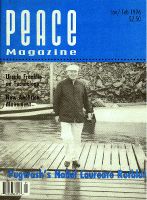
Peace Magazine Jan-Feb 1996, page 23. Some rights reserved.
Search for other articles by Pat Kipping here
This article was prompted by a statement attributed to Rose Dyson in the September/October issue of Peace Magazine. She said that media education is no solution to the problem of television violence. Pat Kipping disagrees.
When my children were young, in a well-meaning effort to protect them from the horrors of TV and play violence, I became, like many good parents and peace activists, an unwitting participant in what Elizabeth Thoman at the Centre for Media Literacy in Los Angeles calls the circle of blame. This is how it works. Viewers blame the producers for making violent programs. Producers blame the broadcasters for wanting programs that get high ratings. Broadcasters blame the advertisers for sponsoring highly rated programs regardless of content. Advertisers blame the viewers for watching and pushing up the ratings of violent shows. We're only giving them what they want, they say. Everyone blames the government.
For 40 years, concerned parents, peace activists, and others have been indulging in this blaming exercise. It hasn't achieved anything. In fact, the amount of violent images and toys that children can see has increased dramatically over the past 40 years.
While we, and everyone else in this circle of blame, point self-righteous, accusing fingers at one another, waiting for someone else to do something, millions of children are sitting, while you read this article, in front of a TV or computer screen being thrilled, confused, or terrified by the violence they are seeing. It will have lasting effects. If we are genuinely concerned about today's children, then we must break this circle of blame and do something now.
Media literacy is a strategy which can be implemented immediately to change the way children are affected by violent television. In the long run, I am certain that a comprehensive campaign of critical media literacy education will result in better television. I hope that eventually, a critical mass of media literate viewers will prove those advertisers wrong and drive down ratings for cheap, gratuitous violence. I know many producers would jump at the chance to make creative, pro-social, intelligent entertainment for children and adults. But in the short term, in the current climate of deregulation and self-regulation where corporate market values rule, I believe that media literacy is the ONLY way to effectively deal with television violence.
In order to understand how media literacy can accomplish this, it is necessary to shift our thinking about the media away from the idea that it is a problem that can be solved or a system that can be resisted and accept that television, indeed all mass media, are here to stay. They have become an environment that must be navigated. Remember what Marshall McLuhan said in his famous book, The Medium is the Message: Any understanding of social and cultural change is impossible without a knowledge of the way the media work as environments.
Media literacy is a well-developed tool we can use today to help our children understand and learn to navigate this treacherous environment. Parents and educators can use its strategies to teach children and other viewers how to read between the lines of television.
Media literate people understand that television is constructed to convey ideas, information, and news from someone else's perspective. They understand that specific techniques are used to create emotional effects. They can identify those techniques and their intended and actual effects. They are aware that all media benefit some people and leave others out. They can pose and sometimes answer questions about who are the beneficiaries, who is left out and why. Media literate people seek alternative sources of information and entertainment. Media literate people use television for their own advantage and enjoyment. They are not used by television for someone else's advantage. Media literate people know how to act. They are not acted on. In that way, media literate people are better citizens.
That's what I really want for my children and all the other children who will be adults sooner than the CRTC can say let's consult on this some more... I want them to have the resources to act for change in a world that increasingly allows too many children to experience the violence of poverty, abuse, and neglect.
Ursula Franklin once said, Violence is resourcelessness. Critical media literacy is an important resource we must develop in our children. It would be a form of violence to deny them this resource while we wait for something better to come along.

Peace Magazine Jan-Feb 1996, page 23. Some rights reserved.
Search for other articles by Pat Kipping here